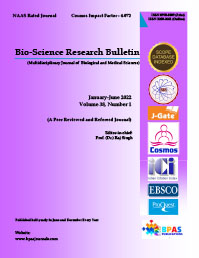A Cross Sectional Study of the Relationship between Fibonacci Ratio and Trigger Finger
DOI:
https://doi.org/10.48165/Keywords:
Fibonacci sequence, Fibonacci ratio, trigger finger, equiangular spiralAbstract
Introduction: Trigger finger is one of the most common causes of hand pain in adults. The pathophysiology is unclear but inflammation and age-related degeneration have been suggested. The equiangular spiral is one of the most engaging patterns which perfectly formed flawlessly executed by transitory movement of the digits in the adaptability of the human hand. This study was done to find out the relationship between the Fibonacci ratios of the finger with trigger fingers. Method: Forty-eight patients who had trigger finger and undergone A1 pulley released were being identified and collected. From the hand radiograph, the length of each metacarpal and proximal phalanx was measured manually. The ratio of the metacarpal bony length to the length of the respective proximal phalanx is the Fibonacci ratio of the digit. Results: There was a significant linear relationship found between trigger finger and Fibonacci ratio (p<0.001). Conclusion: Finger Fibonacci ratio significantly determines the smoothness patterns of its tendon movements.
References
Alan LH and Richard LH. (2010). Fibonacci, Littler, and the Hand. Am. Ass. for Hand Surg., 5:364-368.
Beek N, Stegeman DF, Noort JC, Veeger DH, Maas H. (2018). Activity patterns of extrinsic finger flexors and extensors during movements of instructed and non-instructed fingers. J. Electromyogr. Kinesiol., 38:187-196.
Chuang XL, et al. (2017). What triggers in trigger finger? The flexor tendons at the flexor digitorum superficialis bifurcation, J Plast Reconstr Surg., article in press:1-9.
Coldea, R., Tennant, D.A., Wheeler, E.M., et al. (2010). Quantum criticality in an ising chain: experimental evidence for emergent e8 symmetry. J Science. 327:177–180.
Fahey JJ, Bollinger JA. (1954). Trigger-finger in adults and children. J Bone Joint Surg Am., 36:1200-1218.
Gibson CM, Gibson WJ, Murphy SA, et al. (2003). Association of the fibonacci cascade with the distribution of coronary artery lesions responsible for ST-segment elevation myocardial infarction. Am J Cardiol., 92:595-597.
Gorsche R, Wiley JP, Renger R, Brant R, et al. (1998). Prevalence and incidence of stenosing flexor tenosynovitis (trigger finger) in a meat-packing plant. J Occup Environ Med., 40:556-560. 8. Gupta A, Rash GS, Somia NN, Wachowiak MP, Jones J, Desoky A. (1998). The motion path of the digits. J Hand Surg., 23(A):1038-1042.
Jason YS Chan and GH Chang. (2009). The golden ratio optimizes cardiomelic form and function. Irn J Med Hypotheses Ideas. 3:2-5.
Kaplan EB, Spinner M. (1984). Kinesiology of the Hand and Wrist and Muscular Variations of the Hand and Forearm. In: Spinner M editors. Kaplan’s functional and surgical anatomy of the hand. Philadelphia: Lippincott: 284-287.
Korstanje JW, Schreuders TR, Sijde J, Hovius SE, Bosch JG, Selles RW. (2010). Ultrasonographic assessment of long finger tendon excursion in zone V during passive and active tendon gliding exercises. J. Hand Surg. Am., 35:559– 565.
K Uchihashi, T Tsuruta, H Mine, S Aoki, A N-Matsunobu, M Yamamoto et al. (2014). Histopathology of tenosynovium in trigger fingers. J Patho Intern., 64:276–282. 13. Lin GT, Amadio PC, An KN, Cooney WP. (1989). Functional anatomy of the human digital flexor pulley system. J Hand Surg., 14(A):949–956.
Littler JW. (1973). On the adaptability of man’s hand. Hand., 5:187–191.
Makkouk AH, Oethen ME, Swigart CR, Dodds SD. (2008). Trigger finger: etiology, evaluation, and treatment. Curr Rev Musculoskelet Med., 1(2): 92-96.
Moore JS. (2000). Flexor tendon entrapment of the digits (trigger finger and trigger thumb). J Occup Environ Med., 42:526-545.
Morsi DA and Hawary AA. (2013). Sex determination by the length of metacarpals and phalanges: X-ray study on Egyptian population. J Forensic Leg Med., 20(1):6-13. 18. Park AE, Fernandez JJ, Schmedders K, Cohen MS. (2003). The Fibonacci sequence: relationship to the human hand. J Hand Surg Am., 28:157-160.
Saldana MJ. (2001). Trigger digits: diagnosis and treatment. J Am Acad Orthop Surg., 9:246-252. 20. Sbernardori MC, Bandiera P. (2007). Histopathology of the A1 pulley in adult trigger fingers. J Hand Surg Eur., 32:556-559.
Shah A, Rettig ME. (2017). Trigger finger: location and association of comorbidities. Bull Hosp Jt., 75(3):198-200.
Tang JB, Xu Y and Wang B. (2003). Repair strength of tendons of varying gliding curvature: A study in a curvilinear model. J Hand Surg., 28A(2):243–249.
Yilmaz A; Alicioglu B; Süt N; Uluçam E; Çikmaz S. (2010). Radiological in terms of artistic anatomy. Turkiye Klinikleri J Med Sci., 30(2):690-697.
Zhao CF, Amadio PC, Berglund L, An KN. (2000). The A3 pulley. J Hand Surg., 25(A):270-276.
